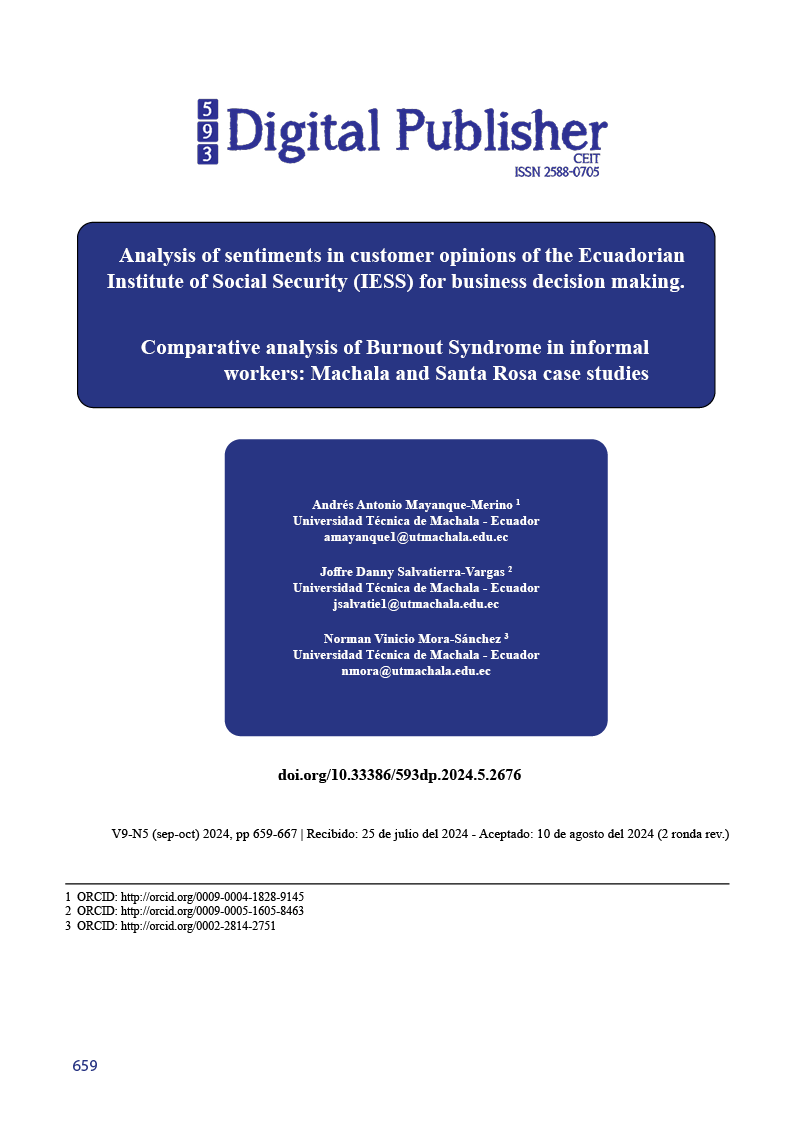Comparative analysis of Burnout Syndrome in informal workers: Machala and Santa Rosa case studies
Main Article Content
Abstract
This research makes an approach to chronic work stress (Burnout) of informal workers of Machala and Santa Rosa, in El Oro province. The study is based on the importance and representativeness of the informal sector in Ecuador, and it is striking that academic research production has focused its attention on the formal sector, while informal workers are traditionally exposed to the most adverse working conditions. The objective was to determine the impact of Burnout in informal workers and to compare the categories corresponding to gender, nationality and family role in order to determine which locality represents a greater risk for each group. A descriptive non-experimental cross-sectional methodology with a quantitative approach was used. A sample of 68 and 67 informal workers from Machala and Santa Rosa was taken, and a non-probabilistic intentional sampling technique was applied for the selection of cases. The diagnostic instrument used was the MBI-General Survey. Descriptive statistics (mean, median, range, and standard deviation) and inferential statistics (Kolmogorov-Smirnov normality test, Mann-Whitney U test for comparison of means, and Hedges' corresponding population estimator g) were used to describe the population and test the hypotheses. The results show that the informal sector of the two cantons concentrates different groups in terms of their sociodemographic characteristics; moreover, the labor market in Santander is less demanding than in Machalilla and only significantly affects the perception of professional efficacy.
Downloads
Article Details

This work is licensed under a Creative Commons Attribution-NonCommercial-ShareAlike 4.0 International License.
1. Derechos de autor
Las obras que se publican en 593 Digital Publisher CEIT están sujetas a los siguientes términos:
1.1. 593 Digital Publisher CEIT, conserva los derechos patrimoniales (copyright) de las obras publicadas, favorece y permite la reutilización de las mismas bajo la licencia Licencia Creative Commons 4.0 de Reconocimiento-NoComercial-CompartirIgual 4.0, por lo cual se pueden copiar, usar, difundir, transmitir y exponer públicamente, siempre que:
1.1.a. Se cite la autoría y fuente original de su publicación (revista, editorial, URL).
1.1.b. No se usen para fines comerciales u onerosos.
1.1.c. Se mencione la existencia y especificaciones de esta licencia de uso.
References
Arrieta-Arrieta, A., & Marrugo-Arnedo, C. (2020). Factores determinantes de la transición entre los sectores formal e informal en México, 2010 y 2017. Revista de Economía del Caribe(26), 1-18. http://www.scielo.org.co/scielo.php?script=sci_arttext&pid=S2011-21062020000200048#:~:text=Se%20seleccion%C3%B3%20como%20formal%2C%20aquellos,en%20micro%20y%20peque%C3%B1as%20empresas.
Asuncion, R. (2022). The Cost of the Covid-19 Pandemic on the Quality of Life of Vulnerable Workers: The Case of the Philippines. Safety and Health at Work, 13, S274. https://doi.org/10.1016/j.shaw.2021.12.1607
Bresó, E., Salanova, M., & Schaufeli, W. (2007). NTP 732: Síndrome de estar quemado por el trabajo "Burnout" (III): Instrumento de medición. https://www.insst.es/documents/94886/326775/ntp_732.pdf
Código del Trabajo. (16 de diciembre de 2005). Codificación 17. Registro Oficial Suplemento 167. https://www.ces.gob.ec/lotaip/2020/Junio/Literal_a2/C%C3%B3digo%20del%20Trabajo.pdf
Díaz-Sánchez, J., & Correa, H. (2024). Immigration and formal labor market participation in Ecuador: Empirical insights from a developing nation. Research in Globalization, 8, 1-10. https://doi.org/10.1016/j.resglo.2024.100198
empleo informal. (s.f.). Organización Internacional del Trabajo. https://www.oitcinterfor.org/taxonomy/term/3366
Ernst, C., & Leung, V. (2023). Comercio e informalidad: transición a la formalidad y trabajo decente. Integración del comercio y el trabajo decente, 1, 1-3. https://www.ilo.org/es/media/515941/download
Essue, B., Kapiriri, L., Mohamud, H., Vélez, M., & Kiwanuka, S. (2024). Planning with a gender lens: A gender analysis of pandemic preparedness plans from eight countries in Africa. Health Policy OPEN, 6, 1-11. https://doi.org/10.1016/j.hpopen.2023.100113
Hedges, L. (1981). Distribution theory for Glass's estimator of effect size and related estimators. Journal of Educational Statistics, 6(2), 107-128. https://doi.org/10.3102/10769986006002107
Hernández, O. (2021). Aproximación a los distintos tipos de muestreo no probabilístico que existen. Revista Cubana de Medicina General Integral, 37(3), 1-3. http://scielo.sld.cu/scielo.php?script=sci_arttext&pid=S0864-21252021000300002
Hidajat, T., Edwards, E., Wood, R., & Campbell, M. (2023). Mindfulness-based interventions for stress and burnout in teachers: A systematic review. Teaching and Teacher Education, 134, 1-19. https://doi.org/10.1016/j.tate.2023.104303
Huynh, T., Oddo, V., Trejo, B., Moore, K., Quistberg, D., Kim, J., Diez-Canseco, F., & Vives, A. (2022). Association between informal employment and depressive symptoms in 11 cities in Latin America. SSM - Population Health, 18, 1-8. https://doi.org/10.1016/j.ssmph.2022.101101
Instituto Nacional de Estadística y Censos. (2024). Encuesta Nacional de Empleo, Desempleo y Subempleo (ENEMDU). https://www.ecuadorencifras.gob.ec/documentos/web-inec/EMPLEO/2024/Trimestre_I/2024_I_Trimestre_Mercado_Laboral.pdf
Instituto Nacional de Estadística y Censos. (s.f.). Censo Ecuador. https://www.censoecuador.gob.ec/data-y-resultados/
López-Contreras, N., López-Jiménez, T., Horna-Campos, O., Mazzei, M., Anigstein, M., & Jacques-Avinó, C. (2022). Impacto del confinamiento por la COVID-19 en la salud autopercibida en Chile según género. Gaceta Sanitaria, 36(6), 526-533. https://doi.org/10.1016/j.gaceta.2022.04.002
McCammon, L., Gillen, P., & Kernohan, W. (2023). Explaining and addressing the limitations in usefulness of available estimated prevalence figures relating to burnout in family doctors: Evidence from a systematic scoping literature review. Journal of Psychiatric Research, 158, 261-272. https://doi.org/10.1016/j.jpsychires.2022.12.013
Naidoo, R. (2022). Protecting the Unprotected – Occupational health and safety among informal workers in Southern Africa. Safety and Health at Work, 13, S10. https://doi.org/10.1016/j.shaw.2021.12.731
Nikunlaakso, R., Selander, K., Oksanen, T., & Laitinen, J. (2022). Interventions to reduce the risk of mental health problems in health and social care workplaces: A scoping review. Journal of Psychiatric Research, 152, 57-69. https://doi.org/10.1016/j.jpsychires.2022.06.004
Organización Internacional para las Migraciones. (marzo de 2024). Estudio sobre movilidad humana en el contexto del cambio climático: Identificación de vacíos de información. https://nortedecentroamerica.iom.int/sites/g/files/tmzbdl1276/files/documents/2024-03/estudio-sobre-movilidad-humana-en-el-contexto.pdf
Patlán, J. (2022). Construcción y validación de una Escala Demanda-Control-Apoyo para medir el estrés laboral. Revista Medica Herediana, 33(1), 24-34. https://doi.org/10.20453/rmh.v33i1.4165
Secretaría de Política Sindical - Salut Laboral. (2009). Síndrome del tunel carpiano laboral. https://www.sesst.org/wp-content/uploads/2021/05/2.-tunel-carpiano.pdf
Vivolo, M., Owen, J., & Fisher, P. (2024). Psychological therapists’ experiences of burnout: A qualitative systematic review and meta-synthesis. Mental Health & Prevention, 33, 1-12. https://doi.org/10.1016/j.mhp.2022.200253




